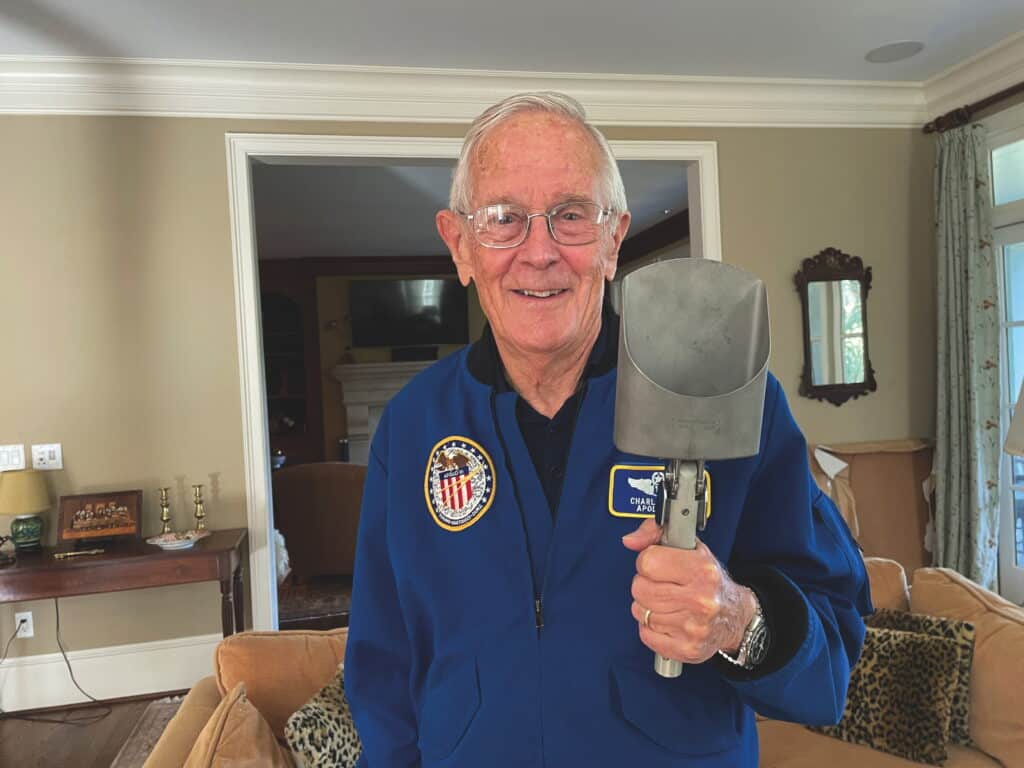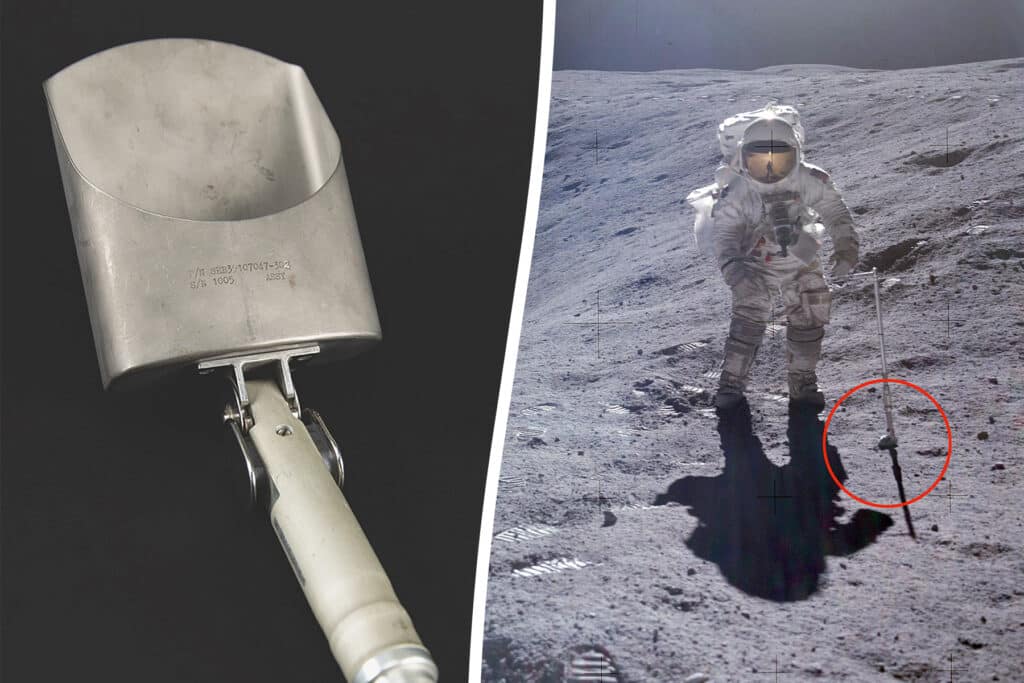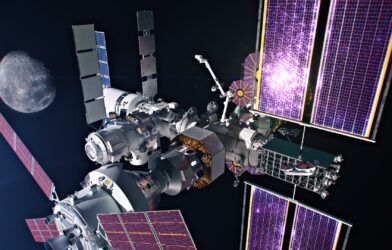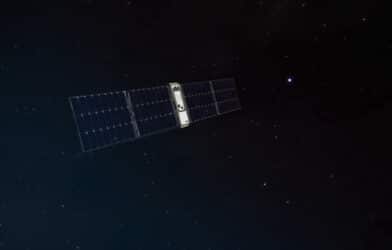If you’re looking to add a prominent piece of space exploration history to your mantel, you’re in luck. The “moon rock scoop” that was instrumental in NASA’s Apollo 16 mission is set to be auctioned.
This iconic tool, used extensively by Lunar Module Pilot Charlie Duke and Commander John Young, is anticipated to bring in over $824,000. It comes from Duke’s personal collection of mission mementos.
Referred to as a shovel, the tool was officially designated on the Apollo 16 stowage list as “Scoop, Large Adjustable.” It played a crucial role during the historic 1972 Apollo 16 mission, the fifth in which humans landed on the Moon.
Young and Duke spent over 20 hours on conducting three separate moonwalks during the mission. The astronauts depended on this instrument to collect 211 pounds (95.8 kilograms) of lunar samples, highlighting its critical role in the mission’s success. There is abundant video footage and photographs documenting the use of this scoop throughout the mission.
Among the many lunar samples procured using this tool, the standout is “Big Muley,” a 26-pound (11.7 kg) moon rock. This rock is the most massive specimen collected throughout the entire Apollo program.
“I had to, one time, pick up a rock that was probably the size of a watermelon, and I could not pick it up with one hand,” Duke recalls in an interview ahead of the auction (see video below). “So I put the shovel down and leaned on towards it, and rolled this rock up my side with my right hand, and was able to roll it up my leg and cradle it like a little baby, and take it back to the Lunar Module.”

As the Lunar Module pilot of Apollo 16, Duke earned the distinction of becoming the tenth individual and the youngest at 36 years and 201 days, to set foot on the Moon.
The design of the scoop was advanced for its era. It featured a pole segment and spring-loaded buttons, allowing it to rotate to 180°, 45°, and 90° positions. This feature made it easy for astronauts to dig, scoop, and scrape.
Visible abrasions on the scoop’s blade bear witness to its heavy use in lunar sample collection.
“What distinguishes this scoop is its unique status as a lunar artifact that made its way back to Earth. Among the successful Apollo lunar landing missions, only one other lunar scoop (from Apollo 14) was returned,” Boston-based RR Auctions writes. “The rest were left on the moon to save weight for the return flight, including the handle extension for this very scoop.”
“From the moment Charlie Duke presented this scoop to us, I recognized its significance as the most important lunar artifact we’ve ever had,” adds Bobby Livingston, Executive Vice President at RR Auction.
This scoop will be available at the Space Exploration and Aviation auction hosted by RR Auction, concluding on October 19.
Facts and figures from the Apollo 16 mission
Apollo 16 was the fifth mission in which humans landed on the Moon and the penultimate mission of NASA’s Apollo program. Here are the key details about the Apollo 16 mission:
Launch Date: Apollo 16 was launched on April 16, 1972, from the Kennedy Space Center in Florida.
Command Module: The Command Module was named “Casper,” and it was the spacecraft used for the return journey to Earth.
Lunar Module: The Lunar Module, named “Orion,” was used for the moon landing.
Crew:
- John W. Young (Commander): This was his fourth spaceflight, and he later went on to fly the Space Shuttle.
- Charles M. Duke Jr. (Lunar Module Pilot): He and Young explored the Moon’s surface together.
- Thomas K. Mattingly II (Command Module Pilot): He stayed in lunar orbit aboard the Command Module while Young and Duke descended to the lunar surface.
Lunar Landing Site: The chosen site for landing was the Descartes Highlands, a region not previously visited. Scientists believed this area would provide evidence of lunar volcanic activity, though it was later determined that the formation was due to impact events, not volcanic activity.
Lunar Surface Activities: Young and Duke spent over 20 hours on extravehicular activities (EVAs), conducting three separate moonwalks. They collected samples, set up experiments, and drove the Lunar Roving Vehicle (LRV) to explore more distant locations.
Lunar Samples: The crew collected about 211 lbs (95.5 kg) of lunar samples, including rocks, core samples, and soil.
Scientific Experiments: Among other instruments, the Apollo Lunar Surface Experiments Package (ALSEP) was deployed, which included various scientific instruments to gather data from the Moon’s surface.
Return: The Lunar Module lifted off from the Moon on April 23, 1972, and rejoined the Command Module in lunar orbit. The crew then traveled back to Earth and splashed down in the Pacific Ocean on April 27, 1972.
Significance: Like other Apollo missions, Apollo 16 contributed significantly to our understanding of lunar geology and the Moon’s history. The mission demonstrated the utility of the LRV for extending the range of human exploration on the lunar surface and confirmed that the Descartes region was primarily formed from impact processes rather than volcanism.
The Apollo program concluded with Apollo 17 in December 1972, marking the end of human exploration of the Moon for several decades.
South West News Service contributed to this report.















